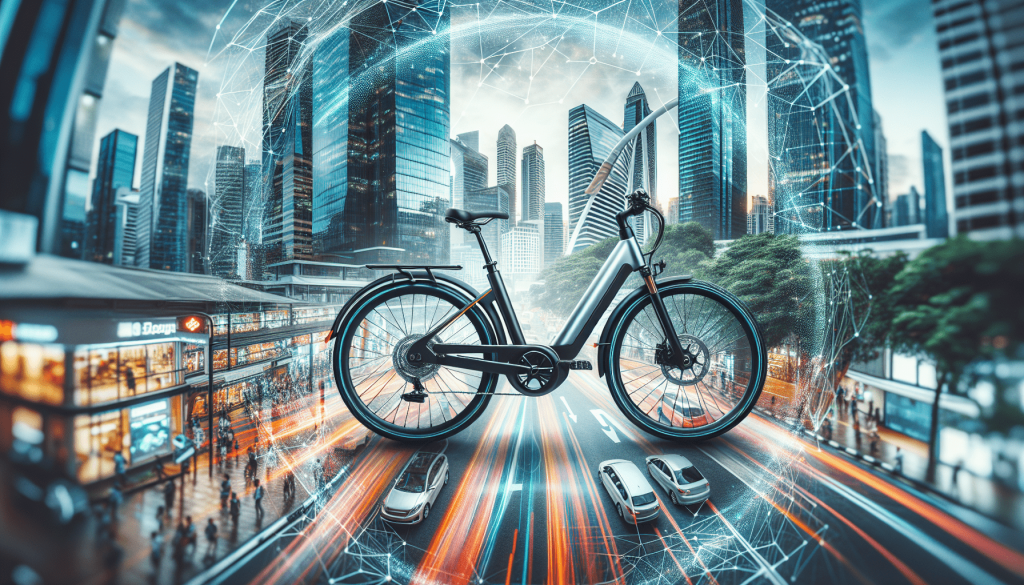What Is The Forecast For Ebike Sales?
Hey there! Have you ever wondered what the future holds for electric bike sales? Well, you’re in luck because we’ve got all the juicy details lined up for you. From the rising popularity of eco-friendly transportation to the advancements in technology, the demand for ebikes is on the rise. Get ready to explore the fascinating world of ebike sales and discover what lies ahead for this booming industry. So hop on your virtual bike, tighten your helmet, and let’s hit the road!

Current State of Ebike Sales
Current Market Demand
The current market demand for ebikes is growing rapidly. With increasing concerns about climate change and environmental sustainability, more and more people are turning to ebikes as a greener alternative to traditional modes of transportation. Additionally, the desire for a more active and healthier lifestyle has also fueled the demand for ebikes. People are increasingly choosing to incorporate physical activity into their daily routines, and ebikes provide an excellent way to do so while still offering the convenience of assisted pedaling.
Trends in Ebike Sales
There are several notable trends in the ebike sales industry. One significant trend is the rise of electric mountain bikes. As outdoor recreational activities gain popularity, more individuals are seeking ebikes specifically designed for off-road adventures. This trend has led to an increase in sales of electric mountain bikes, with manufacturers introducing advanced features such as robust suspension systems and powerful motors to cater to this market segment.
Another emerging trend is the growth of folding ebikes. As urbanization continues and space becomes a premium in cities, consumers are looking for compact and portable transportation options. Folding ebikes provide the perfect solution, allowing riders to easily fold and carry their bikes when not in use. This trend has gained traction in both urban and suburban areas, where commuters and recreational cyclists alike appreciate the convenience and versatility of folding ebikes.
Key Players in the Industry
The ebike market is experiencing stiff competition, with several key players vying for market share. Some notable companies include:
- Bosch: Known for its high-quality electric drive systems, Bosch has established itself as a leading player in the ebike industry. Its reliable motors and batteries are widely used by numerous ebike manufacturers.
- Shimano: Renowned for its bicycle components, Shimano has also made a significant impact in the ebike market. The company offers a range of mid-drive motors and drivetrain systems that are favored by many ebike manufacturers.
- Giant Bicycles: As one of the largest bicycle manufacturers globally, Giant Bicycles has a strong presence in the ebike market. Known for its innovative designs and technological advancements, Giant Bicycles offers a diverse range of ebikes to cater to different consumer preferences.
Factors Driving Ebike Sales
Growing Awareness of Environmental Impact
One of the primary factors driving the increasing sales of ebikes is the growing awareness of their positive environmental impact. As people become more conscious of the need to reduce carbon emissions and minimize their ecological footprint, they are turning to greener transportation options. Ebikes, with their electric motors and ability to replace fossil fuel-powered vehicles, have gained popularity as a sustainable and eco-friendly mode of transportation.
Increasing Popularity of Active Lifestyles
The emphasis on leading an active and healthy lifestyle has also played a significant role in driving the sales of ebikes. Many individuals are seeking ways to incorporate physical activity into their daily routines, and ebikes offer a convenient solution. The electric assist feature allows riders to easily overcome physical limitations and enjoy the benefits of cycling while minimizing strain. This appeal has attracted a diverse range of consumers, including fitness enthusiasts, commuters, and recreational riders.
Government Initiatives and Incentives
Government initiatives and incentives have contributed significantly to the growth of ebike sales. Many countries have implemented policies and programs aimed at promoting sustainable transportation, including financial incentives for purchasing ebikes. In addition, some governments have invested in the development of cycling infrastructure, such as dedicated bike lanes and charging stations, to support the widespread adoption of ebikes. These efforts have encouraged more people to explore the benefits of ebikes and have acted as catalysts for increased sales.
Challenges in Ebike Sales
High Initial Costs
One of the main challenges in the ebike sales industry is the relatively high initial costs associated with purchasing an ebike. Compared to traditional bicycles, ebikes often come with a higher price tag due to the inclusion of electric motors and batteries. This can be a deterrent for budget-conscious consumers who may opt for cheaper alternatives or stick to traditional bikes. However, it is worth noting that the long-term cost savings, especially in terms of fuel and maintenance expenses, can offset the initial investment.
Limited Charging Infrastructure
Another challenge faced by the ebike industry is the limited availability of charging infrastructure. While the range of modern ebikes has significantly improved, riders still need access to charging stations for longer or multi-day trips. Unlike traditional bicycles, which can be easily parked and locked, ebikes require charging facilities to replenish their batteries. The lack of charging stations in certain areas can limit the usability and convenience of ebikes, especially for those who rely on them for long-distance travel.
Perceived Safety Concerns
Despite the numerous safety features and advancements in technology, some consumers still harbor perceived safety concerns when it comes to ebikes. This apprehension may stem from a lack of understanding or misconceptions about the capabilities and limitations of ebikes. Additionally, the integration of electric motors into bicycles introduces a new element of speed and power, which can be intimidating for those unfamiliar with ebikes. Addressing these concerns through effective education and safety campaigns can help alleviate consumer apprehension and encourage greater adoption of ebikes.
Opportunities for Ebike Sales
Expansion into New Markets
The ebike industry presents significant opportunities for expansion into new markets. As awareness and demand for ebikes continue to grow, manufacturers can explore untapped regions and demographics. For example, targeting urban areas with high commuter traffic can introduce a new customer base that values convenience and sustainability. Additionally, exploring markets with rising disposable incomes and a growing appreciation for outdoor recreational activities can present avenues for growth and market penetration.
Technological Advancements
Technological advancements present opportunities for further growth and innovation in the ebike industry. As battery and motor technologies continue to evolve, manufacturers can develop more efficient and powerful systems. Longer battery range, quicker charging times, and improved motor performance can enhance the overall riding experience and attract more consumers to choose ebikes over traditional bicycles or other transportation options. Moreover, advancements in connectivity and smart features can provide riders with additional functionality and convenience, further enhancing the appeal of ebikes.
Product Innovation
Product innovation plays a crucial role in driving ebike sales. By continuously developing new features and designs, manufacturers can cater to evolving consumer preferences and differentiate themselves in a competitive market. For example, integrating lightweight materials and sleek designs can attract consumers who prioritize style and aesthetics. Similarly, offering customizable options in terms of frame size, color, and component choices can appeal to consumers seeking a personalized riding experience. Continuous product innovation ensures that ebikes remain appealing and relevant in an ever-changing market.

Regional Analysis of Ebike Sales
North America
In North America, the demand for ebikes has been steadily increasing. The region boasts a growing trend of active and sustainable lifestyles, making ebikes an attractive choice for commuting and recreational purposes. Moreover, government initiatives aimed at reducing carbon emissions and improving infrastructure for cycling have further boosted the ebike market. While the market is somewhat fragmented, with various local and international players, there is significant potential for growth in North America.
Europe
Europe is one of the largest markets for ebikes globally. The region has a well-established cycling culture, and ebikes have gained widespread acceptance as an alternative mode of transportation. Additionally, favorable government regulations and incentives, such as subsidies and tax benefits, have contributed to the rapid growth of the ebike market in Europe. Major cities in Europe have also invested in cycling infrastructure, including dedicated bike lanes and charging facilities, further facilitating the adoption of ebikes.
Asia Pacific
The Asia Pacific region has witnessed substantial growth in the ebike market, driven by increasing urbanization and rising disposable incomes. Countries like China, Japan, and South Korea have emerged as key players in the manufacturing and consumption of ebikes. The region’s large population, densely populated cities, and congested traffic conditions make ebikes a practical and convenient transportation option. Furthermore, initiatives to reduce pollution and promote clean energy solutions have further fueled the demand for ebikes in the Asia Pacific region.
Latin America
Latin America has also experienced significant growth in the ebike market. The region’s sprawling urban areas, traffic congestion, and limited public transportation infrastructure have made ebikes an attractive option for many commuters. Additionally, the increasing awareness of environmental sustainability and a desire to reduce carbon emissions have influenced the adoption of ebikes in Latin American countries. Manufacturers have recognized this potential and are investing in expanding their presence and distribution networks in the region.
Middle East and Africa
While still relatively nascent, the ebike market in the Middle East and Africa has shown promising growth. The region’s unique geographical landscape, with its varying climates and terrain, presents both opportunities and challenges for ebike manufacturers. With the rising interest in tourism and outdoor recreation, there is a growing demand for ebikes across the Middle East and Africa. Moreover, government initiatives focused on promoting sustainable transportation and combating air pollution have created a favorable environment for ebike sales in the region.
Market Forecast and Projections
Revenue Growth
The market forecast for ebike sales indicates substantial revenue growth in the coming years. With increasing demand and expanding markets, revenue from ebike sales is expected to experience steady growth. Factors such as rising disposable incomes, government incentives, and technological advancements are projected to drive sales and contribute to revenue growth in the ebike industry.
Unit Sales
Unit sales of ebikes are also expected to witness significant growth. As consumer awareness and acceptance of ebikes continue to rise, more individuals are embracing the benefits and convenience of electric-assisted bicycles. The growing popularity of active lifestyles, the shift towards sustainable transportation, and the continual improvement of ebike technology are projected to drive an increase in unit sales globally.
Segmentation Analysis
The segmentation analysis of the ebike market reveals opportunities for targeting specific consumer segments. Demographic factors such as age, income level, and lifestyle preferences can influence the purchasing decisions of potential ebike buyers. Different segments, such as fitness enthusiasts, urban commuters, and outdoor adventurers, may have varying preferences and requirements when it comes to ebike features and functionality. Understanding and catering to these unique segments can help manufacturers tailor their products and marketing strategies to effectively capture the desired market share.

Competitive Landscape
Market Competition
The ebike industry is highly competitive, with numerous manufacturers vying for market share. Established companies such as Bosch, Shimano, and Giant Bicycles face competition from both local and international players. Local manufacturers often have an advantage in terms of market knowledge and distribution networks, while international players bring technological advancements and brand recognition. The competitive landscape necessitates continuous innovation, product differentiation, and effective marketing strategies to maintain or gain a competitive edge.
Strategies Adopted by Key Players
Key players in the ebike industry adopt various strategies to differentiate themselves and capture market share. Some companies focus on technological advancements, continuously investing in research and development to improve battery efficiency, motor performance, and overall ride experience. Others emphasize product design and aesthetics to attract consumers who prioritize style and visual appeal. Additionally, partnerships with retail networks and local distributors can facilitate market penetration and increase brand visibility.
Regulatory Environment and Standards
Ebikes Classification and Regulations
The regulatory environment surrounding ebikes varies across different regions and countries. Many jurisdictions classify ebikes based on factors such as motor power, top speed, and pedal-assist capabilities. These classifications determine where ebikes can be ridden, the age restrictions for riders, and any licensing or registration requirements. Manufacturers and riders must familiarize themselves with the specific regulations in their respective regions to ensure compliance and avoid any legal issues.
Safety Standards
Safety standards for ebikes are essential to protect riders and ensure the integrity of the industry. Manufacturers are required to adhere to specific safety standards set by regulatory bodies. These standards often cover aspects such as maximum speed limits, braking performance, lighting requirements, and battery safety. Compliance with safety standards helps build consumer confidence in the product, reduces the risk of accidents or malfunctions, and fosters a positive perception of the ebike industry.
Infrastructure Development
Infrastructure development plays a crucial role in supporting the growth of the ebike industry. Dedicated bike lanes, charging stations, and secure parking facilities are essential to cater to the needs of ebike riders. Governments and local municipalities can play an active role in developing cycling infrastructure by investing in these facilities and incorporating them into urban planning initiatives. The presence of adequate infrastructure can significantly enhance the safety and convenience of ebike riders, thereby encouraging greater adoption.

Consumer Behavior and Preferences
Demographics of Ebike Buyers
Ebike buyers come from a diverse range of demographic backgrounds. While there is a growing interest across all age groups, certain demographics have shown particular enthusiasm for ebikes. Younger buyers, especially millennials and Gen Z, tend to value sustainability, convenience, and technological advancements, making them more likely to embrace ebikes. Additionally, the aging population, including baby boomers and seniors, appreciates the electric assist feature, which allows them to enjoy cycling without excessive physical exertion.
Factors Influencing Purchasing Decisions
Multiple factors influence the purchasing decisions of potential ebike buyers. Price is often a significant consideration, and affordability plays a crucial role in attracting consumers. Buyers also look for reliability, product quality, and warranty coverage to ensure they are making a sound investment. Additionally, factors such as battery range, charging time, riding comfort, and overall design aesthetics can sway purchasing decisions. Manufacturers that can offer a balance between price, quality, and features are likely to attract a larger customer base.
Conclusion
Summary of Forecast
The overall forecast for ebike sales is optimistic, with substantial growth projected in the coming years. Factors such as the growing awareness of environmental impact, the increasing popularity of active lifestyles, and government initiatives and incentives are expected to drive sales and revenue growth. Technological advancements and product innovation provide opportunities for manufacturers to expand their market reach and cater to evolving consumer preferences.
Future Outlook for Ebike Sales
Looking ahead, the future outlook for ebike sales appears promising. As the global focus on sustainability and active lifestyles continues to grow, ebikes are positioned to become a popular choice for transportation and recreation. The industry will likely see further advancements in battery and motor technologies, improved charging infrastructure, and increased standardization in regulations and safety standards. With ongoing market expansion, increased consumer awareness, and technological progress, ebike sales are set to soar in the coming years.








